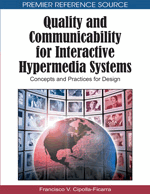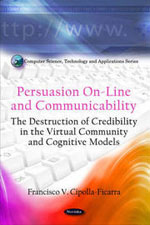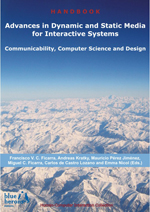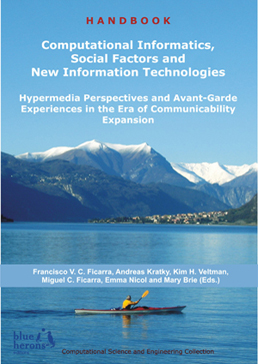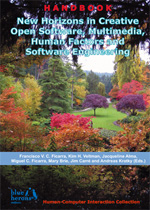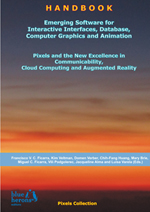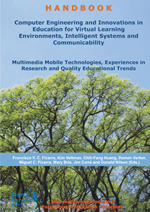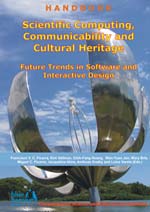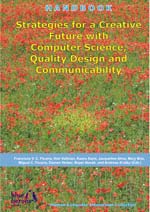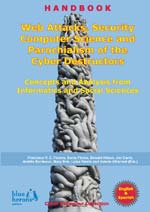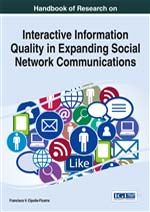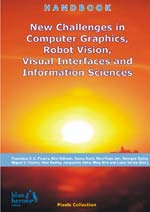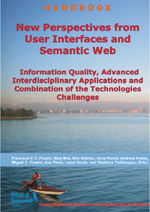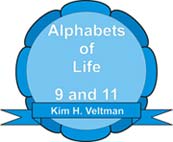New Challenges in Computer Graphics, Robot Vision, Visual Interfaces and Information Sciences
:: Pixels Collection ::
:: Revised Selected Chapters ::
Main Editor: Francisco V. C. Ficarra
Co-editors: Kim Veltman (Maastricht, Netherlands), Kaoru Sumi (Hakodate, Japan), Wen-Yuan Jen (Miaoli, Taiwan), Georges Győry (London, UK), Miguel C. Ficarra (Spain and Italy), Alan Radley (London, UK), Jacqueline Alma (Vancouver, Canada), Mary Brie (La Valletta, Malta), and Luisa Varela (Perpignan, France)
Editorial Assistants: Jim Carré (Willemstad, Curaçao) and Donald Nilson (Norway, Oslo)
Book Details
• ISBN: 978-88-96471-47-0 :: DOI: 10.978.8896471/470
• Publisher: Blue Herons Editions
• Location: Italy (Bg)
• Subjects: Alphabets, ArahDrape, Design, Google, Infographics, Interfaces, HCI, 3D Vision
• Subjects: Communicability, Robotics, Software, Hardware, Symbols, Mass Media, Shading
• Subjects: Quality, Computer Animation, Information, Semiotics, Multimedia, Cloud Testing
• Subjects: Computer Graphics, Interaction, Cross-Cultural Communication, Digital Natives
• Subjects: Facebook, UX, Grounded Cognition, ICT, Colour Stamps, Cultural Heritage, R&D
• Subjects: Machine Translation, Intercultural Collaboration, Gaming Simulation, Numismatic
• Subjects: Textile, CAD, PANTONE Fashion, SNS, Social Networking Sites, Photo Tagging
• Copyright: 2015
• Collection: Pixels
• Series volume: II
• Publication date: December, 2015
• Binding: Paperback
• Grade level: General
• Language: English
• Illustrations: Yes
• Colour: Yes
• Pages: 276
• Dimensions: 11.41x8.26x0.7 in. 1.70 lbs. :: 290x210x18 mm. 775 gr.
Preface
Small minds are concerned with the extraordinary, great minds with the ordinary.
Blaise Pascal (1623 – 1662)
In the interactive process of transforming binary data into information; specifically in order to be able to make decisions and to gain feedback from the interactive exploration cycle, the sense of sight occupies a prevailing place.
The depiction of all manner of information classes/types on the different computer devices; using a wide and motley range of screens, interactive design models, interfaces and metaphors, etc., is a process which turns the once static process of information analysis into a corresponding frontier of perpetually improving research, development capability and new methods of qualitative research. .
These methods represent change variables and know-how that are constantly being employed, transformed and updated; either by humans, automatically and/or as a result of cyclic feedback, everywhere in the world, and on a moment by moment basis. Such changes sometimes represent new steps in the research pathway, or jumps towards unseen areas of technological development.
It is towards those novel pathways or areas to which the content of this handbook is aimed/targeted. In this sense we have established four great cardinal points to orient the contributions and which are tending to generate different perspectives or 360º visions of mankind’s various digital domains.
That is, unions and/or intersections of the different theories, techniques, experiments, results, future research, etc, which taken together enrich the daily growth and evolution of the digital pixel, and all its derivations. The diversity of topics and listings of the chapters likewise denotes the wealth and breadth of the compilation of research works that is attempted.
For this reason each of the topics have been broken down further into simpler subsets or keywords, which doesn’t mean that other great challenges for the short, middle and long term future related to the four central axes have been excluded. An extensive listing connotes and reflects the requirement and also skill necessary to find intersection zones of the disciplines among the different domains, fields, and specialities; which at the same time potentially boosts and merges the formerly different scientific views, and achieves the worthy and rewarding end purpose of improving the quality of life of the current and potential users of the interactive systems.
Besides, some contributions collected in the book have been evaluated and corrected prior to publication in an anonymous way by an international scientific committee. In some cases, said studies have been put forward orally (papers, short papers, research-in-progress, etc.), with their corresponding demos, that is, accompanied with practical/theoretical cases in international conferences, workshops and symposiums such as: MSIVISM 2015 (2nd International Conference on Multimedia, Scientific Information and Visualization for Information Systems and Metrics), SETECEC 2015 (4th International Conference on Software and Emerging Technologies for Education, Culture, Entertainment, and Commerce), CCGIDIS 2015 (5th International Symposium on Communicability, Computer Graphics and Innovative Design For Interactive Systems), HIASCIT 2015 (3rd International Conference on Horizons for Information Architecture, Security and Cloud Intelligent Technology), HCITOCH 2015 (6th International Workshop on Human-Computer Interaction, Tourism and Cultural Heritage), ADNTIIC 2015 (6th International Conference on Advances in New Technologies, Interactive Interfaces and Communicability), HCITISI 2015 (3rd Argentine Conference on Human-Computer Interaction, Telecommunications, Informatics and Scientific Information), and RDINIDR 2015 (1st International Conference on Research and Development in Imaging, Nanotechnology, Industrial Design and Robotics). In the next section a short introductory presentation of the chapters that make up the current handbook is given:
In the research work “A Cross-Cultural Communication: Christianity and the Alphabet” is made apparent the splendid didactic quality in the detailed explanations by Kim Henry Veltman. The research starts with a global and detailed view of the evolution of the alphabet and the links that are established with the UNESCO cultural heritage in Ravenna (Italy), and the different beliefs among the peoples of the planet across the history of humankind. It is an intercultural work where it can easily be seen how the structure of language affects the human conception of the world. Simultaneously the author establishes interrelations which have a big impact on the conformation of the interfaces and in a special way the textual information. Finally, through the vital connections between letters, words, numbers and images that the author masterfully has been establishing along the sections, an interesting line is opened for future research in the context of the translations in the internet.
The chapter “Contributions to HCI: Introducing the CC-Model and its Pro Forma Abstracts” is essential to detect the constant contributions in the framework of Human-Computer Interaction (HCI) which directly and indirectly boost the formation of an unprecedented model by their authors: Marjolein Jacobs, Koen van Turnhout, Arthur Bennis, Sabine Craenmehr, Ralph Niels, Lambert Zaad, and René Bakker. They intend with their model and with the help of a pro-forma, abstract way to facilitate comprehension as well as the writing of abstracts for papers in a simple and clear way. To such purpose, they present a novel tool to study the abstracts in HCI through a corpus of study of 30 years. Besides, they have set up an empirical literature study on a substantial set of abstracts of contemporary HCI papers to indicate the interrelation between contributions, and analyzed the relationship between research methodology and contribution. The results of these analyses have been consolidated in the the Connected Contribution-Model and in pro-forma abstracts. Step by step, in each one of the sections that make up the investigation, it is feasible to see the great contribution that their authors are currently making inside the HCI.
The authors of the work titled “Analysis of Multilingual Interactions in Machine Translation-Mediated Gaming Simulation” are Taishi Nose and Reiko Hishiyama. It is a work which studies the importance of the online translations through interactive game systems, intercommunication among the different agents who participate in the communication process and the global and local cultural factor, especially in the Japanese and Korean cultures. They have analyzed and determined behaviour protocols in a multilingual gaming simulation by using good quality tags, for example. Consequently, in the current work we stress, among others, the following notions: intercultural collaboration; machine translation, crosslingual communication; participatory simulation; and gaming simulation. Each one of the lessons is accompanied with excellent examples which facilitate and speed up the reading of the text, especially in the strategies followed in the experiments carried out with users to reach the results which are exposed.
Andreas Kratky is the author of a theoretical study under the title “Thinking with Our Hands –Theoretical Foundations of Multimodal Interfaces in Concept-Forming”. This work intends to demonstrate the possibilities of expansion of the multimodal interfaces in the cognitive activities related to memory, the organization of information and the conformation of concepts. It is a theoretical study tending to shape the bases for future research and carry out experiments. The author focuses his research mainly on haptic interfaces. The focus of haptic interface implementations is generally the production of perceivable physical stimuli through vibration, electro motors and other means of generating actual forces. In other words, the use of the hands, the arms, etc., in view of the new interfaces and last generation interaction systems available in the museums, the touristic information stands, etc. The key words which can orient the reader of the current research are: Multimodal interfaces, pseudo-haptic information seeking, search interfaces and grounded cognition. Starting from the conclusions and the learned lessons it is feasible to establish interesting research lines related to the current theoretical context, whether it is in the short, middle or long term.
In the chapter called “An Innovative Concept for Automated Cloud Testing Platform” their authors are Chi-jung Li and Heh-jiann Shih. They have developed an unprecedented cloud testing platform tending to lessen the costs in several senses. Whether it is through a reduction of the time used, a smaller number of people for such tasks, as well as diminishing the total of necessary equipment. All of that while maintaining the quality and efficiency of the results obtained. In other words, it is presenting the equation in order to increase the quality and cut the costs to reach it. In the Cloud Open Lab a set of methods is introduced which boost those goals. They are widely described along the pages in an entertaining and simple way. The graphics included by their authors also facilitate a better understanding of the advantages presented with the new methodology. The interested reader will find a series of cases for study, with their matching comparative results in order to quickly understand the interesting conclusions submitted by their authors.
The digital natives are one of the groups of study in the work called “Facebook Photo Tagging Culture and Practices among Digital Natives” whose authors are Aqdas Malik, Amandeep Dhir, and Marko Nieminen. They have focused on the Social Networking Services in a country with an exquisite millennial culture like India. In their work the authors analyze the interaction between users (digital natives) and the new technologies, in order to establish guidelines and recommendations at the moment of developing interactive systems. They have focused on the use of Flicker for adult users. It is a study where digital photography and the applications such as Facebook find a common area. For that reason the authors present in detail the motivations, experiences and gratifications of adult Hindus associated with Facebook, photo tagging. The results of the experiments carried out serve as a guide for the development of interfaces, contents, etc., of the interactive systems, dividing the female and masculine population, for instance.
The authors of the chapter “Design and Robotics: A Teaching Experience” are Maximiliano Romero and Andrea Bonarini. They submit a splendid didactical experience in the field of the Human-Robot Interaction from three perspectives: interdisciplinary, multidisciplinary, and transdisciplinary. The experience refers to groups of works made up by design and engineering students. They have become users of their own robots once the design, prototype and testing of said robots was accomplished. Although the background of the training and experiences of each one of the participants was variegated, the results have been excellent from the didactic and research point of view, as well as the integration among the users, the designers and the engineers. This didactic experimentation has as its genesis a course made up by three main areas: Lessons and laboratory work, autonomous development and user evaluation. The set of the images of the different projects serve to better orient the degree of width of the didactic experimentation and the shortness of the available time to reach the planned results.
Under the title of “ArahDrape: Texture Mapping for Web Presentations”, its authors Anton Gregorčič and Dušan Peterc present us a texture mapping software for the textile CAD "ArahDrape" through an exemplary tutorial. Across its pages the potential of the software can be seen, tending to facilitate the tasks of the designers and other participants in the fabrication and marketing process of clothes. Its authors have made an effort in simplifying the complexity of carrying out designs in the textile sector. This simplification is facilitated through a didactic methodology in keeping with the potential users of the CAD system, irrespective of the place where they are, designing and/or producing clothes. Simultaneously the software makes apparent the current areas which must be covered inside graphic computing, an application such as abc, for texture mapping, whether it is in the industrial context as the incorporation of those images in the internet. The purpose is to generate the catalogues of the collections, facilitating the access to thousands of potential online users, for instance. Lastly, given the high versatility of the software, its use is feasible in other fields of computer graphics, such as can be computer animation of 3D characters and virtual scenarios, where the tissues must have an excellent realism quality.
In the chapter “Design and Art: Numismatics and Philately History in the Republic of San Marino” is analyzed by Gioia Giardi, the historical evolution of the post and stamps service of the Republic of San Marino. Through this history, graphic design has taken a place of privilege. Besides, we analyze the constant evolution of philately and numismatics of San Marino, regarded as a source of income for the local economy. Finally are included many examples of that evolution in one of the first republics of the world and with a four-centuries long history starting from the 2D design until reaching 3D avant-garde designs such as the post cards for the visioning of three-dimensional stamps.
“Pixels Innovation” is the title that the author has chosen to explain a series of articles published in the specialized technical press in Spain in the transition between the 20th century and the new millennium. The articles are extracted from one of the first sections related to computer graphics, computer animation, information technology, design, multimedia, virtual reality, national and international conferences (main topics: information and communication technologies), etc., with local and global difussion (i.e., the Americas). These issues made up a big set of works related to the real and/or virtual image in 2D and/or 3D, whether it is dynamic and/or static, called inphographics in Spain. The use of the term referred to the French notion of infographie, and the Anglosaxon computer graphics. In the set can be detected a pioneering composition style in the dissemination of scientific knowledge and prevention of the human and/or social factors from the educational context towards the public in general, in the Spanish technical press. Lastly, a diachronic-synchronic mechanism is included to understand the latent interrelations between text and society through truthful and verifiable synthesis which allows to establish the human and professional consequences in the exercise of freedom of expression within and without the Spanish borders.
Francisco V. C. Ficarra
Rio, Brazil (December 2015)
Partial Content On-line (pdf format)
• Front Cover (here)
• Preface :: Acknowledgment (here)
• Chapters :: Final Remarks :: Author Index :: Keywords Index :: References ... (here)
• Back Cover (here)
Additonal Handook Info
• Only paper copy – no digital book on-line and/or off-line –
• Special Price € 95 (expedition cost not included) ... e-Commerce :: Info Form
Welcome to Blue Herons Editions!
The origin of this publishing project is to be found in the Canadian lands, where nature presents itself generous in many places of its wide geography. More...
Education, Communicability, Design, Computer Science, HCI, Computer Graphics and Computer Animation:
We focus on education and new technologies with 35 years long experience. More...
Literature and Journalism:
Intersection between universal literature, local new journalism (true stories), sociology and legal immunity. Two collections:
- Casoncelli Bergamaschi
It is a typical bergamasque dough filled with meat, similar to the raviolis. More...
- Menjar Blanc & Black
It is a typical sweet of the Catalan coast and the Balearic Islands. More...
Others Releases:
See all others new releases in books, CD, DVD, etc. More ...
Call for Papers: ADNTIIC 2016 :: HCITOCH 2016 :: SETECEC 2017 :: HIASCIT 2016 :: CCGIDIS 2017 :: IPCTIIC 2016 | HCITISI 2016 :: MSIVISM 2017 :: RDINIDR 2016 :: ESIHISE 2016

